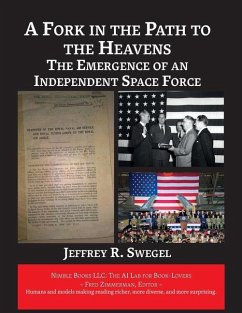
Fork in the Path to the Heavens
The Emergence of an Independent Space Force
Versandkostenfrei!
Versandfertig in über 4 Wochen
15,99 €
inkl. MwSt.

PAYBACK Punkte
8 °P sammeln!
The issues confronted by Britain and the U.S. early in the last century regarding their emerging air power capabilities were hotly debated, and the final decisions for the creation of independent Air Forces was made based on several factors, not all of which have been sufficiently explored. In the same way today, due to its huge technological advantages, the United States faces a difficult decision with regard to its space forces. The arguments for or against creation of an independent space force all have merit, but the final decision will have lasting impact on national defense. This monogra...
The issues confronted by Britain and the U.S. early in the last century regarding their emerging air power capabilities were hotly debated, and the final decisions for the creation of independent Air Forces was made based on several factors, not all of which have been sufficiently explored. In the same way today, due to its huge technological advantages, the United States faces a difficult decision with regard to its space forces. The arguments for or against creation of an independent space force all have merit, but the final decision will have lasting impact on national defense. This monograph examines the current environment with regard to United States space capabilities in an attempt to determine when, if ever, the nation should create an independent service for space. To do this, it uses the U.S. Army concept of Force Development to analyze the Doctrine, Training, Leadership, Organization, Materiel and Soldier (DTLOMS) development processes. First it evaluates the concepts and programs of Britain and the United States during their attempts to come to terms with early 20th century emerging air power capabilities. This sets the framework for the reader and provides insight into the reasons why separation of the air arm was necessary if those nations were to maintain their warfighting capabilities. Once the groundwork is laid by looking at early air power, an examination of current U.S. Army, Navy and Air Force policies toward their respective services' space cadres is made using the same DTLOMS criteria to determine the effectiveness of each service's approach. Finally, by comparing the air power and space situations, and placing the latter within current U.S. national security objectives, it makes a judgment as to the effectiveness of the current space structure. The author asks if national interests would best be served by creation of an independent service now, and if not, what conditions could present themselves that would cause the national needs to best b This work has been selected by scholars as being culturally important, and is part of the knowledge base of civilization as we know it. This work was reproduced from the original artifact, and remains as true to the original work as possible. Therefore, you will see the original copyright references, library stamps (as most of these works have been housed in our most important libraries around the world), and other notations in the work. This work is in the public domain in the United States of America, and possibly other nations. Within the United States, you may freely copy and distribute this work, as no entity (individual or corporate) has a copyright on the body of the work. As a reproduction of a historical artifact, this work may contain missing or blurred pages, poor pictures, errant marks, etc. Scholars believe, and we concur, that this work is important enough to be preserved, reproduced, and made generally available to the public. We appreciate your support of the preservation process, and thank you for being an important part of keeping this knowledge alive and relevant.






![Captain Kettle on the War-path [microform] Cover Captain Kettle on the War-path [microform]](https://bilder.buecher.de/produkte/65/65558/65558877n.jpg)





